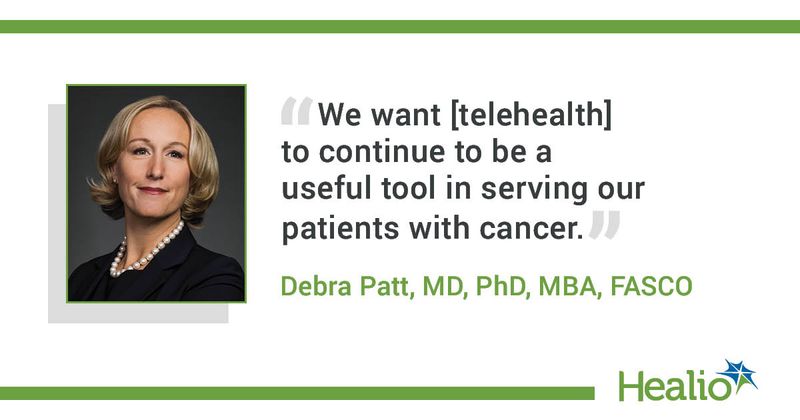ASCO standards aim to ensure appropriate use of telehealth in oncology
Click Here to Manage Email Alerts
Like many of the services rapidly adopted during the COVID-19 pandemic, telehealth seems certain to become a permanent part of the cancer treatment landscape.
To address the widespread use of telehealth and its potential implications, ASCO formed an expert panel and conducted a systematic review of the literature on telehealth in oncology. This led to the creation of ASCO standards and practice recommendations to guide use of the technology.

“Telemedicine has been an incredible tool throughout the pandemic to provide service to patients with cancer, but we want to make sure it is delivered in alignment with quality-based guidelines,” panel member Debra Patt, MD, PhD, MBA, FASCO, executive vice president of Texas Oncology, said in an interview with Healio. “When people don’t use it in the way it was intended, its usefulness is diminished. So, we wanted to establish guidance and standards to ensure oncologists have a consistent way to use telehealth. We want it to continue to be a useful tool in serving our patients with cancer.”
Patt spoke with Healio about the development of these recommendations, their value in optimizing telehealth and the potential future of remote care.
Healio: What goals did the expert panel have in developing these recommendations?
Patt: Most of us have used telehealth quite a bit and championed telemedicine programs in our own practices. So, we’re very familiar with the opportunities and challenges of telemedicine implementation. We wanted to standardize patient selection and implementation of telehealth in oncology. We characterized many different scenarios where regular telemedicine evaluation would be appropriate to guide and direct ways in which people would use telehealth, both to make sure it was used appropriately and to ensure that we could enlighten people not currently using it in every possible scenario.
Healio: What data did the panel use to formulate the recommendations?
Patt: We reviewed the American Telemedicine Association guidelines, as well as state and federal policies that pertain to telemedicine.
Healio: What did the panel determine in terms of what situations would be suitable for a telehealth appointment?
Patt: An individual with a physical exam finding that needs to be assessed but cannot be visualized on a telemedicine platform might not be the best candidate. Patients who do not have a computer, smartphone or access to service that would allow them to use a bimodal audio and video platform would not be good candidates for telemedicine visits. Some situations that would be suited to a telehealth appointment include new patient visits, medication prescribing and management, prechemotherapy evaluations, acute care issues that might otherwise require a trip to the hospital or ER, supportive care visits, compliance visits, family counseling, genetics visits, post-discharge coordination, routine follow-up and survivorship.
Healio: How might telehealth services be misused or abused?
Patt: Since March of 2020, when there was broad, sweeping support for telemedicine, I have heard some payers anecdotally express concern about providers who are inappropriately overusing telemedicine. This has not been my experience in oncology at all, but I think these guidelines will enable us to audit oncology visits to demonstrate their utility. If there is concern globally about misuse, then people will not use it as much and insurance won’t pay for it. That would be devastating for patients with cancer.
Healio: How has the COVID-19 pandemic revealed the usefulness of telehealth?
Patt: Prior to the global pandemic, people used telehealth predominantly for acute care visits with providers other than their established clinicians. What we’ve learned from the pandemic is that the real service to patients is in longitudinal care in chronic diseases such as cancer, where patients can have telemedicine visits with their providers and we can perform medication changes, acute care visits and other support virtually and take care of patients where they are. So, that’s the big message — making sure we use it appropriately so we can continue to provide this incredibly useful tool to the patients we serve.
For more information:
Debra Patt, MD, PhD, MBA, FASCO, can be reached at Texas Oncology, 204 Balcones Drive, Austin, TX 78731; email: debra.patt@usoncology.com.

